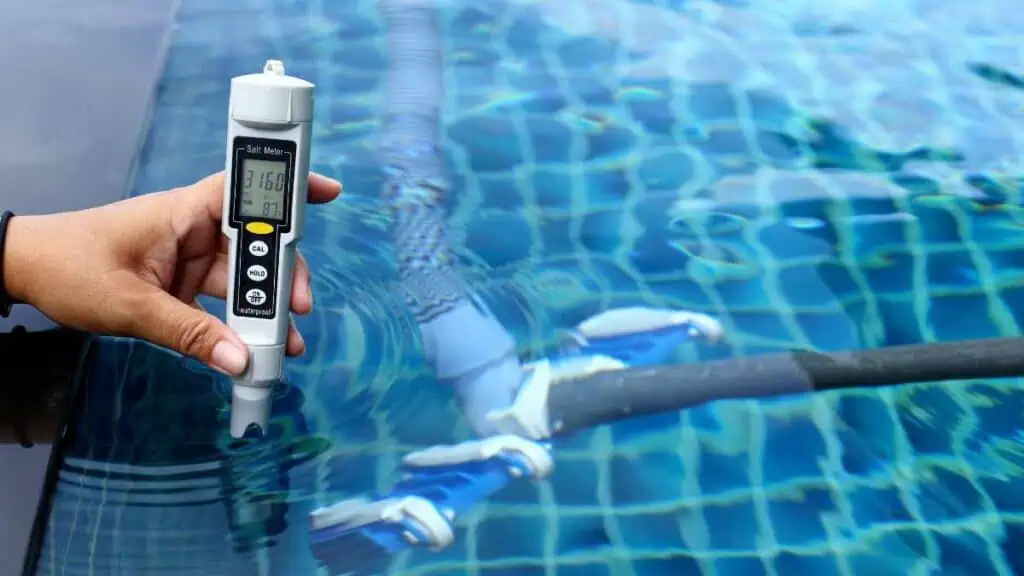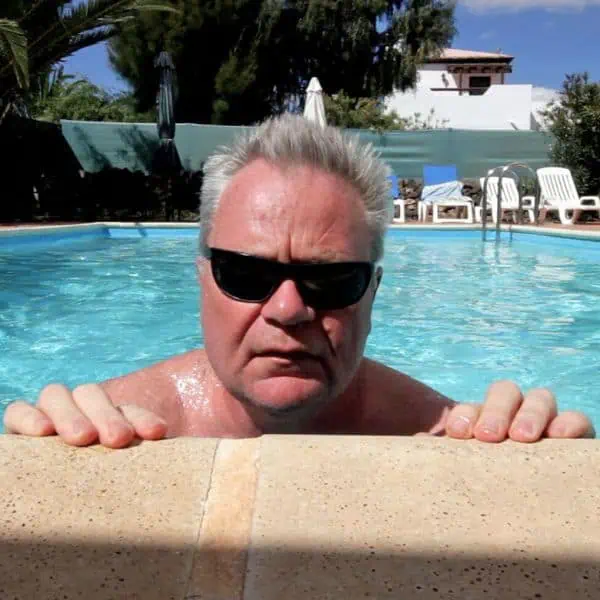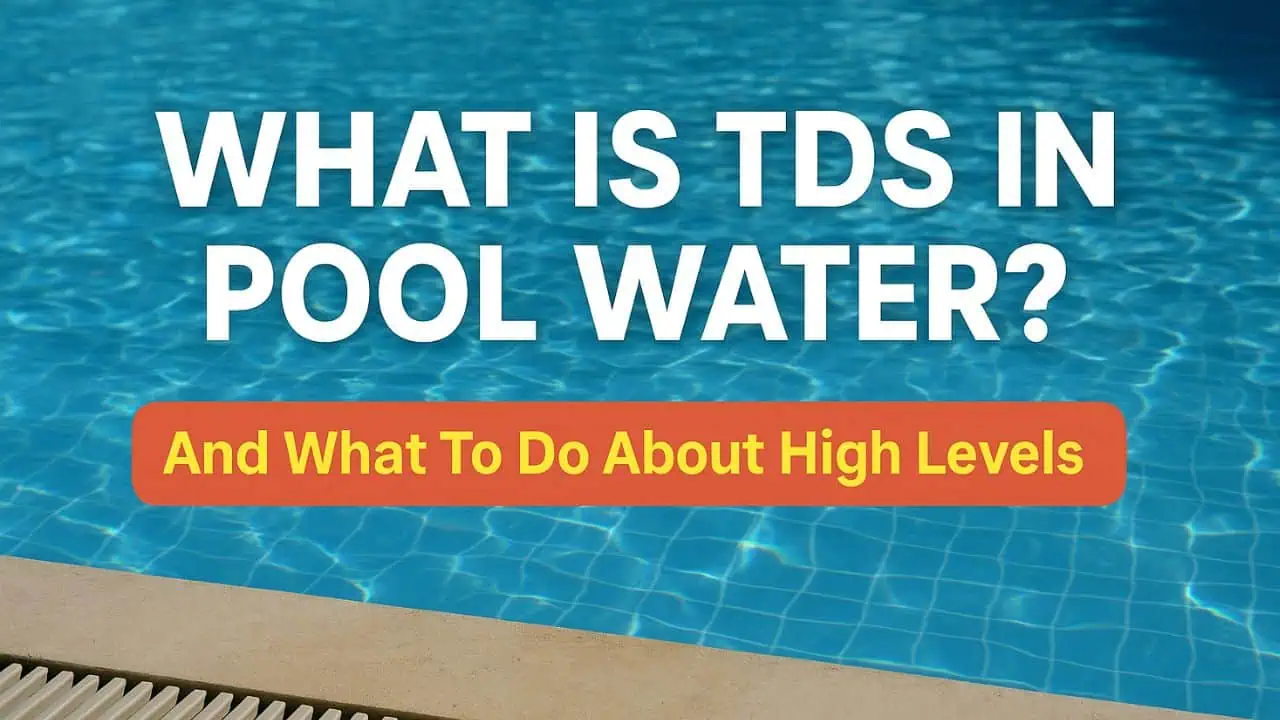You will also need to increase your pool’s salt levels if you’ve recently drained your pool, partially or fully, or if your chlorinator control box indicates low salt levels.
Keeping your salt swimming pool in optimal condition includes understanding how to maintain the proper salinity levels.
Learning how much salt to add to pool water is a crucial factor in ensuring clean, clear, and safe water for you and your family to enjoy.
We will guide you through the process of determining the correct salt levels for your pool, addressing common concerns, and sharing tips to make your pool maintenance easier.

How to Test Salt Level in Pool
It is essential to check the existing salt levels in your pool water before taking any action. This can be done by either taking a water sample to a pool store for professional testing or using a salt test kit.
There are two types of salt testers you can use at home:
- Salt Water Test Strips. You dip a test strip into the pool water and then read the salt level by comparing the color on the strip with the colors on the salt scale.
- Digital Salt Tester. These are very easy to use, even if you are color blind, as the salt level in ppm is displayed on the tester’s screen.
Salt Test Strips
Pool Salt Test Strips
Easy to use salt water testing kit with 0-8000 ppm test range
Determine the volume of your pool
In order to determine how much salt you need to add to your pool, you will need to know the volume of water in your pool. If you don’t know your pool’s volume then you can calculate it using the following methods.
Once you have measured your pool’s dimensions, you can use a formula to calculate its volume. The formula you use will depend on the shape of your pool.
- For rectangular pools, the formula is length x width x depth x 7.5.
- For circular pools, the formula is 3.14 x radius x radius x depth x 7.5.
- For kidney-shaped or irregularly shaped pools, a rough estimate can be used.
It’s important to remember that the volume of your pool is measured in gallons.
Pool Volume Calculator
Please enter your pool shape and dimensions:
Read my full article on calculating a pool’s volume
How much salt to add to pool
The quantity of salt to be added depends on the pool water’s initial salt level.
- For a new or recently filled pool likely having zero salt level, 50 lbs of salt per 2,000 gallons of water is needed to achieve 4000 ppm.
- For pools already in use, existing salt levels will be present due to prior usage of chlorine tablets or bleach. In this case, test the water first and add the necessary amount of salt in a few stages, testing in between, to reach 4000 ppm.
| Salt Level | 10,000 gallons | 20,000 gallons |
|---|---|---|
| 0 ppm | 300 lbs | 600 lbs |
| 1,000 ppm | 225 lbs | 450 lbs |
| 2,000 ppm | 150 lbs | 300 lbs |
| 3,000 ppm | 75 lbs | 150 lbs |
How to add salt to salt water pool
It is crucial to distribute the salt around the pool as evenly as possible. I normally snip off the corner of the salt bag and then slowly walk around the side of the pool pouring the salt in as I go. This is best done when there is little wind, otherwise, some of the salt will be blown away from the pool.
Once I have poured the salt around the edge I then pour salt into a bucket and then walk around again throwing salt from the bucket out into the middle of the pool.
If using granular salt, a high percentage of it will dissolve before reaching the bottom.
The remaining undissolved salt will slowly dissolve over time. To speed this up, keep the pump running for 24 hours to allow for even salt distribution throughout the pool. This process can be sped up even more by ensuring the bottom drain is open so that water is drawn in from the bottom of the pool.
If your pool doesn’t have a bottom drain you can attach a pool vacuum to the skimmer and place the vacuum head on the bottom upside down. You can move it to a different spot every few hours.
What is the best pool salt?
Ensure you use salt specifically intended for pools. The salt obtainable from local pool stores or online is typically suitable for salt chlorine generators.
High-purity sodium chloride salt is ideal and it should have a purity level exceeding 99%. This type of salt is commonly available in 40-80lb bags and is comparable to food-grade salt or water-softener salt.
Avoid using rock salt, as it is challenging to dissolve and lacks purity.
Recommended Pool Salt
Morton Quick Dissolving Pool Salt
All-natural salt that helps your pool remain sparkling clean.
Fast dissolving rate for quick and hassle-free use.
Morton pool salt is gentler on hair, skin, eyes and swimwear.
What happens if salt level is too high in pool?
Over-salting your pool won’t affect your chlorine generator but could result in salty tasting water.
Although this might not be harmful and could even make the swimming experience more enjoyable by matching the body’s natural salinity, excessive chlorine levels above 6000 ppm might corrode metallic pool equipment like ladders, light rings, stainless steel handrails, filters, or copper heat exchangers.
The only way to decrease salt levels is to dilute the pool water by draining some and refilling with fresh water.
How often to add salt to pool
Once you’ve adjusted the salt levels in your pool, it is not normally necessary to keep supplementing it yearly unless significant amounts of water are drained or the pool is entirely emptied. Determining the precise quantity of salt needed requires knowledge of the volume of water your pool holds.
Salt loss usually occurs through leaks, filter backwashing or vacuuming to waste, rainwater overflow, and splashing out by swimmers.
Water evaporation doesn’t reduce salt, but instead, increases the concentration. The added water that normalizes the water level helps decrease the salt concentration back to 4000 ppm.
Many chlorine generator units have low salt indicators, with digital models showing the pool owner the exact amount of salt needed to restore 4000 ppm.
FAQs
How can I test the salt levels in my pool?
You can test the salt levels by taking a sample of your pool water to a local pool professional for testing, or you can purchase a starter kit from a local pool store and conduct the test yourself.
What type of salt should I use for my pool?
It’s essential to use high-purity sodium chloride salt, ideally with a purity exceeding 99%. This type of salt is commonly available in local pool stores and comes in 40-80lb bags. It’s similar to food-grade salt or water softener salt.
How often do I need to add salt to my pool?
After the initial salt addition, you’ll only need to add more salt when it’s necessary, such as when a significant amount of water is drained from your pool, or when your chlorinator control box indicates low salt levels. Salt levels can also decrease due to leaks, filter backwashing, rainwater overflow, and splashing by swimmers.
What happens if I add too much salt to my pool?
Over-salting won’t harm your chlorine generator but could result in salty tasting water. Extremely high salt levels, over 6000 ppm, could corrode metallic pool equipment like ladders, light rings, stainless steel handrails, filters, or copper heat exchangers.
How can I reduce the salt level in my pool if it’s too high?
The only way to reduce high salt levels in your pool is by dilution. This involves draining some of the pool water and refilling it with fresh water. This process helps decrease the concentration of salt back to the ideal level of 4000 ppm.








Leave a Reply